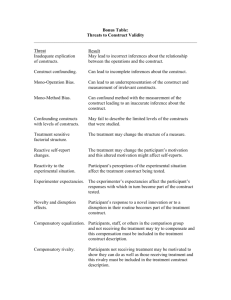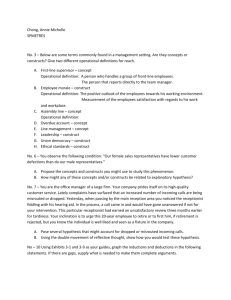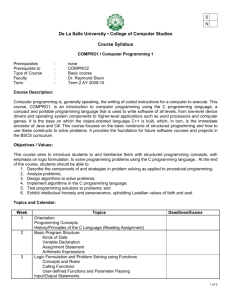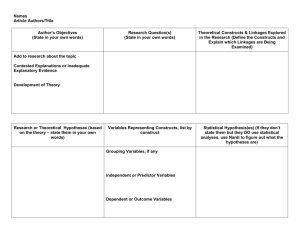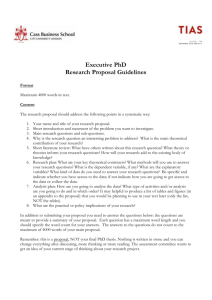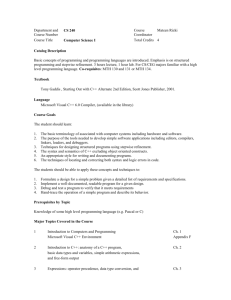Customer usage processes
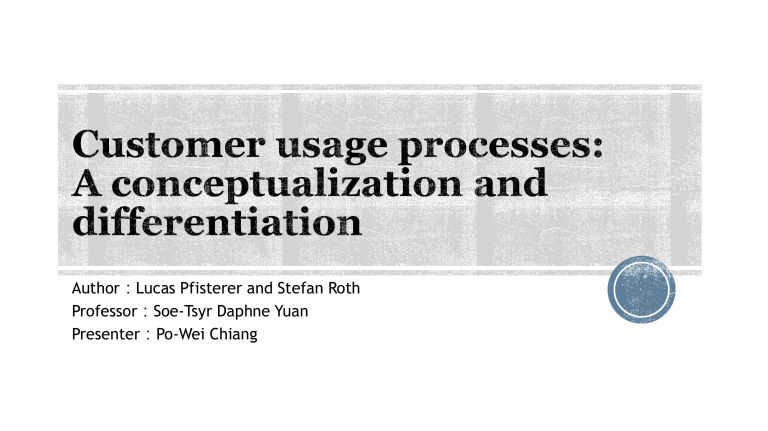
Author : Lucas Pfisterer and Stefan Roth
Professor : Soe-Tsyr Daphne Yuan
Presenter : Po-Wei Chiang
Introduction
Value creation through usage
Dimensions of customer usage processes
Empirical study
Conclusion and further research
2
Embedded in goods production
Customer value
Cocreated by customer and others
Value-in-exchange
Customer usage process
Value-in-use
3
Value creation and the SDL
Customer usage process as part of the value creation process
4
A service is…
Customer
A
Customer
B
Provider
B
Provider
A
Provider
C
Supplier
A
Provider
B
Provider
C
5
Dyadic perspective
Actor to
Actor
Attention to the multiple interactions during the value creation process needs to be highlighted
6
7
Consumption process is more than just using an object process
Goods
Encounter points
Information
Other customers
Have an impact on customer’s value creation
8
In a B2B setting, a buying center with many members in the decider, buyer, and user roles usually represents the customer.
We focus on
single customers
who integrate their resources in a usage process along with the resources of a provider value proposition.
9
It is a process
over time
and not a point in time.
The activities are characterized by the
integration of one or more value propositions
by several actors and at least one provider and one customer.
The provider needs to understand and adapt the value proposition that
best fits the customer resources
.
10
A spontaneously sensing and responding spatial and temporal structure of largely loosely coupled, value-proposing social and economic actors interacting through institutions, technology, and language to
(1) co-produce service offerings
(2) engage in mutual service provision
(3) co-create value (Vargo and Lusch, 2011: 185).
11
This environment encompasses all factors that affect the customer value creation but are not controlled or integrated by any participating actor.
Contextual factors that affect value creation also need to be considered.
For example :
12
Actor intensity
Interaction intensity
Resource intensity
13
All social and economic actors are resource integrators.
Service systems are ‘‘a configuration of resources (including people, information, and technology) connected to other systems by value propositions’’
In particular other customers, as one group of actors, are often highly important during a usage process.
Drink a bottle of water when riding a bike alone in the woods
Low
Concerts or sports events
High
14
Provider sphere
Joint sphere
( Directly )
Customer sphere
( Indirectly )
The use of fast-moving consumer goods
Such as grocery items or toiletries
Low
Visit to a restaurant or a hairdresser
High 15
The literature provides evidence that in comparison with the integrated resources of other actors, especially those of the provider, the integrated resources of the customer differ among usage processes.
To be simplified, customers prefer to be either actively involved in the usage process or passive actors .
Eating dinner at a standard restaurant
Low
Dinning in a fast-food restaurant
High
16
Indirect
Customer’s resource
Direct
Many
Few
Provider’s resource
17
Methodology
Results
Discussion
18
Because the term customer usage process is rather unknown to interviewees and its meaning difficult to decipher .
We decided to employ the repertory grid technique , which is a way of conducting structured interviews.
Their purpose is to identify differences between elements, which can be persons, products, or, in our case, customer usage processes.
19
20
Using a car wash( Low )
few other customers/people are around
during the car wash the user does not interact with the provider directly
the car wash system performs the service fully automated
Dancing in a dance course( High )
many other customers are present
at least one trainer is always present and can be directly interacted with
Customers perform the dancing on their own
21
First, the interviewer familiarized the interviewees on the topic of the research and the different elements.
In the second step, the interviewees randomly chose a triad of different usage processes from the 16 specified usage processes in accordance with the minimum context form proposed by Tan and Hunter (2002).
After completing their choice and uncovering the processes, the interviewees proceeded with a triadic comparison.
Constructs
22
23
Data analysis procedure
Collocation of similar constructs
Reliability check and standardization of category names
Reallocation of constructs and reliability check
Identification of key categories
a frequency count and the average normalized variability (ANV)
24
Data analysis procedure
Collocation of similar constructs
Reliability check and standardization of category names
Reallocation of constructs and reliability check
Identification of key categories
a frequency count and the average normalized variability (ANV)
25
Data analysis procedure
Collocation of similar constructs
Reliability check and standardization of category names
Reallocation of constructs and reliability check
Identification of key categories
a frequency count and the average normalized variability (ANV)
26
Data analysis procedure
Collocation of similar constructs
Reliability check and standardization of category names
Reallocation of constructs and reliability check
Identification of key categories
a frequency count and the average normalized variability (ANV)
27
Data analysis procedure
Collocation of similar constructs
Reliability check and standardization of category names
Reallocation of constructs and reliability check
Identification of key categories
a frequency count and the average normalized variability (ANV)
28
29
30
31
Key category : “Number of actors”
Constructs :
‘‘together/alone’’, ‘‘socially interactive/individually’’
‘‘with fellow users/solo’’, ‘‘group consumption/single consumption’’
Fellow users seem to be a crucial group when differentiating between usage processes with and without other actors being present.
32
Key category : “integrated provider resources”
Constructs :
‘‘human support/machine support’’, ‘‘personal service/automated service’’
Interaction intensity can be specified by the way a provider integrates operant resources into the usage process.
33
Key categories : ‘‘provider support’’ and ‘‘user activity level.’’
Constructs :
‘‘support/do-it-yourself ’’, ‘‘supporting activity/independent performance’’
Customers who are active in a process shape the process by integrating many resources and also control it.
Conversely, usage processes with passive customers rely on integrated provider resources and follow the provider’s lead.
34
It involves the outcome of the process, not the process itself.
35
1.
Provider focus on the development and distribution of value propositions falls too short with regard to value creation for the customer.
2.
Providers of value propositions need to investigate whether actors other than the customer are participating in the usage process and what role they might be playing .
3.
Modification of the value proposition in terms of usage process guidance can make an important difference.
36
1.
How the combination of the different parts of the process contributes to value creation?
2.
Conceptualizing and investigating usage processes and their role regarding value creation in other dyadic relationship settings
(B2B, C2C, government-to-consumer).
37
38

